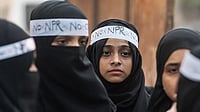When officers of the Mumbai Police questioned Kannada actor Maria Monica Susairaj about her friend Neeraj Grover, an executive with a TV production house, on May 21, 2008, she was completely unfazed. Grover had gone missing on May 6. The police questioned Susairaj several times, but she always had answers ready for them. Finally, Susairaj broke down after several rounds of interrogation and spilled the beans. She had assisted her fiancé Lieutenant Emile Jerome Mathew with disposing of Grover’s body after he was killed by Mathew.
The crime passionnel attracted much attention in the press and the details started emerging slowly. Grover had apparently visited Susairaj at her Malad flat in north Mumbai on the night of May 6 to help her settle in. However, Mathew was not happy to find him with her in the flat when he arrived the next morning. The two men reportedly got into a scuffle and Mathew stabbed and killed Grover then and there.
After the murder, Susairaj apparently went to a shopping mall to buy curtains, sports bags,,knives and room fresheners. She later told the police that she had been instructed by Mathew to do so. The duo cut up Grover’s body into several parts and stuffed them into the bags Susairaj had brought. They loaded the bags in a Santro hatchback she had borrowed from a friend and drove to Manor Wada, a forested area about 80 km north of Malad. They set the bags on fire.
Mathew returned to his naval base and Susairaj went to the Malad Police Station with Grover’s friends to file a missing complaint. In the meanwhile, Grover’s father Amarnath filed a kidnapping case with the police. Susairaj, who was known to be a close friend of Grover, was brought in for questioning, which led to the unravelling of the crime. Susairaj remained calm throughout her interrogation, said a source in the police, but Mathew kept crying. “The murder might have occurred in a fit of jealousy,” said another officer, who was part of the investigating team. “But cutting up the body was well thought out.” Susairaj was found guilty of destroying evidence and was sentenced to three years in prison, while Mathew got a 10-year term for culpable homicide not amounting to murder and destroying evidence.
Sometimes, the crimes are so gory that even the bar gets carried away by the public outrage they cause. There have been instances when the bar called on its member lawyers to not defend the accused. The brutal rape and murder of a 14-year-old girl in Khopardi, a village in Ahmednagar, in October 2016 is a case in point. “Even if your conscience tells you that the person you are defending has committed the crime, you must be professional as a lawyer,” says criminal lawyer Harshad Nimbalkar. “The rules of the Bar Council of India prevent a lawyer from refusing a case without a valid reason. You need to be professional about a trial. There is no room for personal bias.” He adds that a lawyer cannot be intimidated by the heinousness of a crime.
From Jack the Ripper to Raghav
While lawyers and the police have professional training to prevent them from getting intimidated, most people are fascinated by macabre and violent crimes. From the late Victorian London where the infamous Jack the Ripper killed at least five sex workers to Mumbai of the 1960s where Raman Raghav terrorised his victims, violent criminals have inspired novels, films and TV shows. Even the Neeraj Grover murder case apparently made it to the 2011 Hindi film Not A Love Story.
Violent crime has also been studied extensively by criminologists, psychologists and mental health professionals. The American Psychological Association in a 2014 article titled “The criminal mind” claims, “On the outside, violent offenders come in all shapes, sizes, colours, and ages. But on the inside, research finds that they may share some traits.” It adds that researchers are working on interventions to reduce the risk of violent crimes. Valeria Saladino, Hannah Lin, Elisa Zamparelli and Valeria Verrastro write in their article, “Neuroscience, empathy, and violent crime in an incarcerated population: A narrative review”, published in 2021, “Empathy is connected to and involves specific parts of the brain which, if damaged or of reduced volume, can lead to actions that are morally unjust, aggressive, or simply denoting a lack of understanding and sensitivity.”

Raghav, who killed 41 people in two spells between1965–66 and 1968, displayed a considerable lack of empathy. According to some reports, after hitting one of his victims several times on the head with an iron rod, he sat beside the still-warm body and ate a meal of rice and roti he found in his victim’s house. In another instance, Raghav attacked a sleeping woman and her child, had sexual intercourse with the woman’s body after she died. Raghav was finally arrested by a police team led by Alex Fialho at Dongri.
During the trial, the surgeon general of Bombay, as Mumbai was then called, on the instruction of the Bombay High Court, formed a team of psychiatrists to examine Raghav. After conducting five two-hour-long interviews, they found that he was suffering from chronic paranoid schizophrenia. His death sentence was commuted to life in prison. Raghav eventually died at Yerawada Central Jail in Pune on April 7, 1995. The motive for his murders remains a mystery.
The Beer Man Mystery
Raghav is not the only serial killer to have terrorised Mumbai. In October 2006, a lifeless body was discovered near a foot overbridge at Marine Lines in the south of the city. It was identified as that of Vijay Gaud, a taxi driver, who had been bludgeoned to death. Two months later on December 14, another body turned up near Marine Lines. An empty beer bottle was found close by. Over the next few weeks, several more bodies turned up around Marine Lines and Churchgate. There were suspicions of sexual assault. Though beer bottles or cans were found in the case of only two of the victims, the media started calling the suspected serial killer the Beer Man.
Ravindra Kantrole, a small-time gangster, was arrested and charged with the crimes. Kantrole, who had been to jail earlier, had converted to Islam and was called Abdul Rahim. There were rumours that he was a queer or that he hated queers. In January 2007, a sessions court in Mumbai found Kantrole guilty of one murder and sentenced him to life imprisonment. The sentence was, however, overturned and he was declared not guilty by the Bombay High Court in September 2009.

While the Beer Man case remains a mystery, psychiatrist Nisha Mirajkar says that emotionally distressing events in childhood can lead a person to violence. “Emotionally distressing experiences like parents’ divorce have an impact on whether or not psychopathic tendencies become more pronounced,” she says. “Also, children suffering from psychopathic tendencies tend to torture animals for fun. Parents must closely monitor the habits of their children and seek discreet help if they notice anything out of the ordinary.”
According to Mirajkar, there are some biological differences in the brains of psychopaths in comparison to the general population. “Upbringing is an important contributor and has a big impact in the making of a psychopath. An extremely superior complex coupled with a lack of emotion drives a psychopath. A lack of remorse is a dominant emotion. Coming face to face with someone who has committed a heinous crime is unnerving even for the police,” adds Mirajkar. A recent disturbing trend is a rise in necrophilia. “Some police officers are also affected by all that they see. I help them profile and understand the killer.”
Remorseless They Remain
In the barracks of Yerawada Jail are lodged Renuka Shinde and her sister Seema Gavit, both of whom have been convicted of kidnapping 13 children and killing five of them between 1990 and 1996. The sisters were aided by their mother Anjana Gavit. All their victims were below the age of five. Their modus operandi involved picking up the children from crowded places like bus and train stations from small towns in Maharashtra. They would then bring the children to a rented flat in Nashik and force them to beg on the streets. If the children cried too much, they would be tortured and killed.
After their arrest, a sessions court sentenced them to death in 2001. The sentence was upheld by the Bombay High Court in 2004 and the Supreme Court in 2006. Their mercy petitions were rejected by the governor of Maharashtra in 2008 and the President in 2014. However, the Bombay High Court commuted their sentence to a life term in January this year.
Sources in the police said that the Gavit sisters might have kidnapped many more children than they would eventually confess to during their trial. They displayed no remorse while committing the murders. They drowned one of their victims in the bathroom of their rented flat. The body of another victim, who was only two-and-a-half-years old, was stuffed into a bag, which Shinde and Gavit took with them to a cinema. They watched the film while the bag was in their possession and disposed of it on their way back home. “They show no emotion,” says a jail official. “There is no repentance for their deeds.”


























